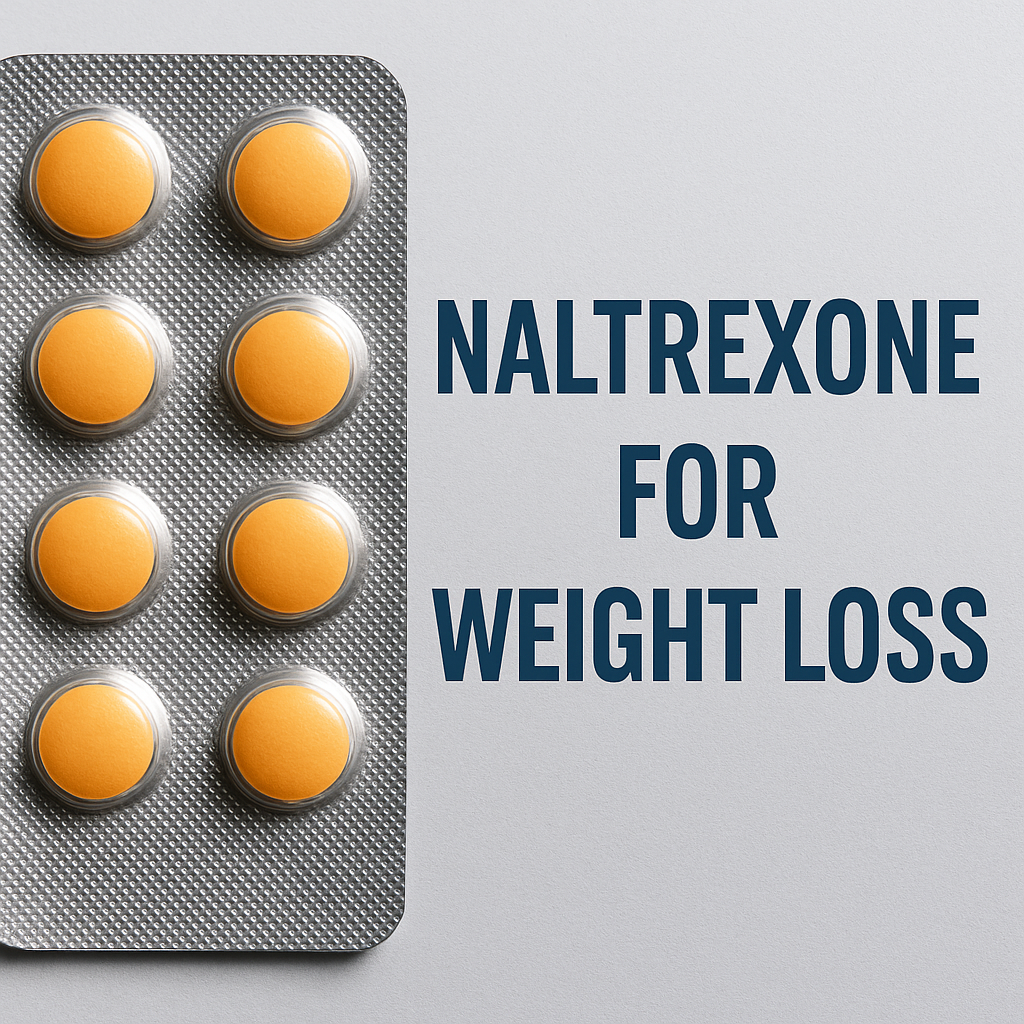What Is Naltrexone?
Naltrexone is an opioid-receptor antagonist—it blocks opioid receptors in the brain. It was originally approved for treating alcohol use disorder and opioid dependence. On its own, naltrexone has not shown significant weight loss effects. The proven approach is a combination with bupropion, an antidepressant also used for smoking cessation.
Naltrexone/Bupropion (Contrave®): The FDA-Approved Combo
The fixed-dose combination of naltrexone extended-release 32 mg and bupropion extended-release 360 mg is sold under the brand name Contrave®. This pairing is FDA-approved for chronic weight management in adults with:
- BMI ≥ 30 (obesity), or
- BMI ≥ 27 with a weight-related condition (e.g., diabetes, hypertension, high cholesterol).
How It Works
- Bupropion activates neurons in the hypothalamus that regulate appetite (POMC neurons).
- Naltrexone blocks the opioid feedback that normally shuts these neurons down.
Together, they create a stronger and longer-lasting satiety signal than either drug alone.
How Effective Is It?
In 56-week clinical trials, patients taking naltrexone/bupropion alongside diet and exercise achieved:
- –5.4% to –8.1% average body weight loss vs –1.2% to –4.9% with placebo.
- 36–57% of patients lost ≥5% of body weight vs 16–43% with placebo.
- 15–35% lost ≥10% vs 5–21% on placebo.
While not as dramatic as GLP-1 medications, these results are clinically meaningful for many patients.
Dosing and When to Stop
Naltrexone/bupropion ER tablets (8 mg/90 mg) are titrated up over 4 weeks to a maintenance dose of 2 tablets twice daily. Therapy should be discontinued at 12 weeks on the full dose if the patient has not lost at least 5% of baseline weight.
Side Effects and Risks
Common side effects include nausea, constipation, headache, dizziness, insomnia, and dry mouth. More serious considerations include:
- Opioid use: Cannot be used if you are taking opioids or in withdrawal, as naltrexone can trigger withdrawal and reduce opioid tolerance.
- Seizure risk: Bupropion lowers seizure threshold—contraindicated in people with seizure history or eating disorders like bulimia/anorexia.
- Blood pressure: Can raise BP and heart rate, requiring monitoring.
- Mental health: Boxed warning for suicidal thoughts/behavior (from bupropion component).
Naltrexone Alone or Low-Dose Naltrexone?
High-dose naltrexone alone has not produced meaningful weight loss in clinical trials. Low-dose naltrexone (LDN), sometimes discussed in wellness circles, lacks robust evidence for weight loss and is considered experimental.
How Does It Compare to GLP-1 Medications?
GLP-1 receptor agonists like semaglutide (Wegovy®, Ozempic®) and tirzepatide (Mounjaro®) have shown significantly greater results, with average weight loss of 15–20% of body weight in trials. By comparison, naltrexone/bupropion averages 5–9%.
However, adding naltrexone/bupropion to a GLP-1 has been studied in some patients who plateau, with evidence suggesting additional weight loss benefits. This combination should only be used under medical supervision.
Comparison Table: Naltrexone/Bupropion vs GLP-1s
| Feature | Naltrexone/Bupropion (Contrave®) | GLP-1s (Semaglutide, Tirzepatide) |
|---|---|---|
| FDA Approval | Yes (for obesity) | Yes (for obesity/diabetes) |
| Average Weight Loss | ~5–9% | ~15–20% |
| Mechanism | Appetite suppression via POMC activation + opioid blockade | Hormone mimic: slows digestion, reduces appetite, regulates blood sugar |
| Common Side Effects | Nausea, constipation, insomnia, headache, BP increase | Nausea, vomiting, constipation, GI upset |
| Best Candidates | BMI ≥30 or ≥27 with comorbidity, no seizure/opioid use | BMI ≥30 or ≥27 with comorbidity, broad candidate pool |
Final Thoughts
Naltrexone for weight loss is effective only when combined with bupropion in the FDA-approved medication Contrave®. Results are modest compared to newer GLP-1 therapies but still meaningful when paired with lifestyle changes. For individuals unable to use GLP-1s, or for those who plateau, naltrexone/bupropion may be a helpful option under medical guidance.
At Health365.Fit, we focus on safe, effective, science-backed weight loss strategies, including GLP-1 programs that are delivering breakthrough results. If you’re exploring medication-assisted weight management, connect with us to find the right path for your goals.


